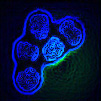
| Until the last fifty years smallpox epidemics that swept through North India, were considered to be a manifestation of the goddess Sitala. Sitala ("cool one") manifests her lila (story) or khel (play or sport) in the individual human, and the disease must therefore be honored as a form of possession by the goddess. When the disease struck, the patient/recipient and the goddess were placated with cooling foods -- cold rice, plantains, yoghurt -- and with offerings of flowers and and coconuts and annointed with cooling neem tree leaves.
|

|
|
| During the festival of Sitala in Salkia, a suburb of Calcutta, activites and foods which promote heat are banned, and images of Sitala are carried to the Hooghly river to cool her with its waters.
|
|

|
| The practice of variolation, introduced before vaccination was perfected, involved the injection of a small amount of smallpox-infected matter into the body of the patient so that the immune system might be exposed to the disease in a controlled fashion. Unlike vaccination, which was considered a direct strike against the will of the goddess, variolation was conisdered to be a method of invoking the goddesses protection instead of violating her claim on the patient's body.
| 
|






